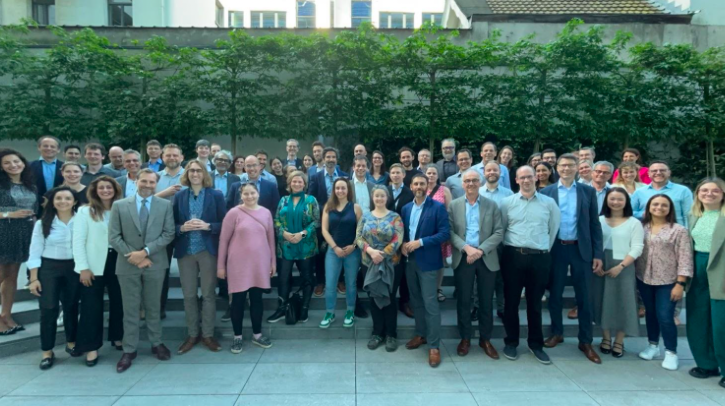TTI speaks to Claire Fioretti, head of standards and regulations for connected mobility, Michelin, about her upcoming presentation at Tire Technology Expo Conference, taking place at the Deutsche Messe in Hannover, Germany, on March 4, 5 and 6. Fioretti will give a presentation on the first day of the Conference about the tire Digital Product Passport (DPP) pilot within CIRPASS2, an EU-funded project to test the DPP at scale.
What is the subject of your upcoming presentation at Tire Technology Expo?
I’m going to talk about the Digital Product Passport (DPP), specifically for tires. I will also present an initiative led by Michelin for the tire industry: a tire Digital Product Passport pilot within the CIRPASS-2 project.
CIRPASS-2 is a European-funded project aimed at testing the DPP at real scale. The goal is to evaluate the tools, IT systems and processes required to implement this system in an interoperable way across different sectors, such as textiles and tires. We need to prove that this unified system will work.
The second objective of CIRPASS-2 is to assess the potential benefits of the DPP for the circular economy, not only for manufacturers like Michelin but also for retreaders, end-of-life tire collectors, and other stakeholders in the tire circular economy. We also aim to identify the conditions for a successful deployment of the DPP, including IT infrastructure, costs and necessary investments that will be required for the industry to enter this new digitalization era.
CIRPASS-2 is an exciting project with many stakeholders working together to make it successful. We plan to return to Tire Technology Expo in the future to present our results, because it will be a very exciting test.
For those unfamiliar with the project, what is CIRPASS-2 about and why did Michelin join a pilot?
CIRPASS-2, funded by the EU under Digital Europe, is designed to test the DPP system. This project builds on CIRPASS-1, which officially started in October 2022 when the European Commission first conceived the idea of a digital product passport to provide access to product sustainability information. CIRPASS-1 made recommendations on how to structure and implement the DPP. Now, CIRPASS-2 aims to put those recommendations into practice, ensuring that the system can work across multiple sectors.
CIRPASS-2 consists of 13 pilot programs spanning textiles, electronics, tires and construction materials — sectors impacted by the European Sustainable Products Regulation (ESPR) or other relevant regulations. The idea is to create a cross-sectoral, interoperable system that supports the DPP.
Additionally, CIRPASS-2 collaborates with CEN and CENELEC, the standardization bodies, to ensure that the DPP aligns with ongoing standardization efforts. The tire industry already has digital assets that can integrate into the DPP system, and Michelin sees this project as an opportunity to further develop these tools and contribute to broader industry standards.
What are the main benefits of the Digital Product Passport for small and medium-size enterprises as well as large organizations?
The core purpose of the DPP is to track and share information about a product throughout its lifecycle. This supports the circular economy by making products last longer, improving repairability and enhancing recycling processes. The European Commission has identified a major challenge: information about products is available in the upstream supply chain but becomes difficult to access once the product reaches the market. For example, tires do not currently have serial numbers printed on them, making individual tracking challenging.
The DPP addresses this by assigning a persistent electronic identifier to each tire, ensuring that information can be accessed at any stage. This benefits manufacturers, retreaders, recyclers and end-of-life collectors by improving traceability and decision making. For Michelin, this means gaining insights into how many tires are retreaded or recycled. For SMEs, while digitization may seem burdensome, the DPP provides standardized and affordable digital tools to support their operations.
Additionally, tire sorting and retreading are not considered “attractive” jobs. Digitization could help improve working conditions by automating processes. For instance, RFID technology in tires can facilitate automated sorting, reducing manual labor and improving efficiency.
How is tire data tracked and collected throughout its lifecycle?
RFID technology serves as the unique identifier supporting the DPP system. This technology has been developed over the past 25 years and was standardized in 2020 across the tire industry. RFID is embedded in the tire before curing and cannot be removed without destroying the tire. It stores only the tire’s serial number, ensuring individual traceability.
The RFID itself is passive, requiring a reader and a resolving mechanism to access the associated data stored in manufacturer and stakeholder databases. The Global Data Service Organisation for Tyres (GDSO) manages this resolution system, directing inquiries to the appropriate database.
A key challenge is capturing lifecycle events, such as retreading or recycling. GDSO is developing a ‘Tire Lifecycle Data Service’, which will enable authorized retreaders and ELT (end-of-life tire) collectors to update the system with retread or recycling declarations. This ensures that data is securely stored and accessible within the decentralized architecture of the DPP.
How will this affect tire recycling and retreading practices?
Within GDSO, we have standardized datasets to describe retread operations, ELT collection and recycling. These datasets will be tested in the CIRPASS-2 pilot to demonstrate the effectiveness of these tools. By digitizing this information, we can improve retreading diagnostics, optimize recycling decisions and create more efficient circular economy practices.
How do you see regulations evolving to support digitalization within the tire industry?
If implemented correctly, the DPP will significantly aid the digitization of the tire industry. The European Commission recognizes that the DPP should go beyond mere regulatory compliance. If the system supports additional use cases — such as fleet management and lifecycle tracking — this will be a major advantage.
The tire industry has already developed digital solutions like RFID and GDSO for internal business needs. If these systems align with the DPP, they will not only ensure compliance but also enhance broader connected mobility applications. Regulation, in this sense, is helping drive digital transformation.
How has international collaboration within CIRPASS-2 supported the project?
For the tire pilot, we are working with partners in France, Germany and Sweden. Our goal is to test the system with independent stakeholders — not just Michelin-affiliated companies — to ensure broad applicability.
These three countries represent different end-of-life tire management systems. France operates under an extended producer responsibility (EPR) model with structured collection and sorting. Germany, in contrast, has a free-market system where collection is based on company-driven initiatives. Sweden has a unique approach focusing on material recovery, with SDAB playing a key role in recycling processes.
We also included BASF in the pilot because they are interested in chemical recycling and closing the materials loop. This diversity of stakeholders allows us to evaluate how the DPP functions in varied regulatory and operational environments.
What key takeaways do you hope attendees will get from your presentation?
Our main objective is to raise awareness about the DPP. The system is coming, and it will be complex and demanding for the industry. Now is the time for stakeholders to get involved and help shape the regulation.
There is concern among some industry players, particularly retreaders and ELT collectors, about data sharing. Some fear that major manufacturers like Michelin will use this data to monitor their businesses. However, the system is designed to ensure data privacy and prevent misuse. Educating the industry and fostering acceptance of the system is crucial.
Ultimately, the DPP is not just a simple tracking tool. It will fundamentally change how data is shared among companies to improve circular economy practices. The more data we collect, the more we will understand the full lifecycle of tires and develop better sustainability solutions. By 2026, Michelin will have enough RFID-equipped tires on the market to test the DPP at scale, providing valuable insights for the entire industry.
Book your conference pass here to attend Fioretti’s presentation, and see the whole line-up of speakers, at Tire Technology Expo Conference 2025.



